#Japanese Gardening Tools Online
Explore tagged Tumblr posts
Text
Understand Basic Wear & Tear Issues Of Chainsaw Bar Chain UK To Get The Best Output
0 notes
Text
Super Monkey Ball: Banana Rumble ‘Adventure’ trailer, assist features and worlds detailed
From Gematsu

SEGA has released a new trailer for Super Monkey Ball: Banana Rumble dubbed the “Adventure” trailer, as well as new information and screenshots on the game’s assist features and worlds.
Here is an overview of the game, via SEGA:
■ A Delightful New Adventure Awaits
While visiting a tropical island, AiAi and the gang meet a girl named Palette, an adventurer searching for the Legendary Banana. They agree to join her on her journey across wondrous worlds to collect special parts said to be the key to locating this prized relic. Along the way, they’ll meet new friends and encounter mysterious rivals. For those unfamiliar with Super Monkey Ball, or simply looking for ways to improve their technique, take advantage of the optional assist features available in Banana Rumble! These include:
The ability to Rewind to a previous point of a stage and attempt a tricky area once more.
A Ghost Guide option, which will add a transparent racer alongside the player, demonstrating the key methods needed to reach the goal.
A Route Guide that will point you in the direction if you’re not sure where to go.
The choice to restart at a Checkpoint within certain stages, and more!
■ Game World Introduction
Adventure Mode features 200 new stages that are set across different worlds, each with their own unique twists and turns that can be experienced either solo, or with others in 4-player co-op! All of this is accompanied by a thrilling story told through fully developed cutscenes. To give just a taste of what fans can expect, SEGA®️ is introducing a stage from each of the mode’s first five Worlds respectively.
World 1: Banana Farm
World 1 is naturally designed to progressively teach players all the tools and tricks to set them up for the rest of their adventure! A great example is the stage “Rail Slider,” where steps and ramps taller than the player’s ball are placed throughout the stage. Use the new technique, Spin Dash, to make it through the steps!
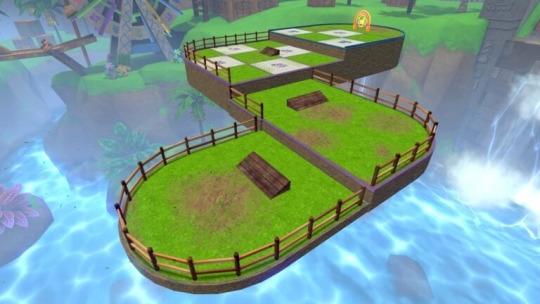

World 2: Rose Garden
In “Wonder Maze,” the stage is designed like a large garden maze. Players will need to look for the correct route to make it to the goal.


World 3: Floating City
The “Switch and Go” stage has switches that move the different scaffoldings. Here, players will need to use switches at the best timing to reach the goal.


World 4: Golden Temple
The “Rolling Balls” stage has giant balls that block the player’s way. Players must maneuver these giant objects to make their way to the end.
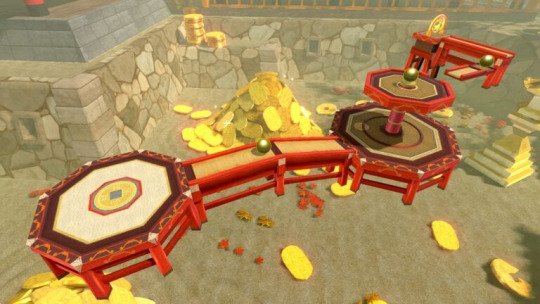
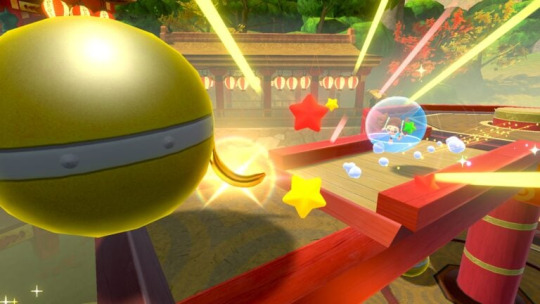
World 5: Stone Valley
The “Rocket Launcher” stage has a goal that is located high in the sky. Use the rocket to get launched up in the air and aim for the goal!
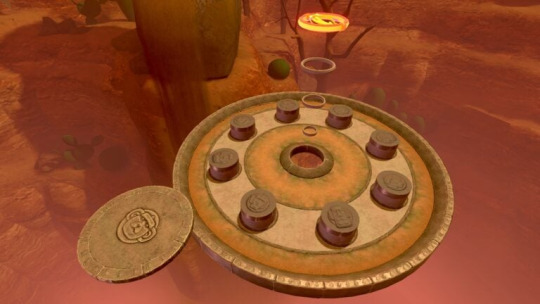

■ Key Features
Experience thrilling gameplay that is easy to pick up and play yet challenging and fulfilling to master.
Go bananas with your favorite bunch and drop into online multiplayer for up to 16 players or local multiplayer for up to four players!
Slip into a wonderfully crafted story either locally or online in the all-new Adventure Mode, where you will journey through 200 newly crafted stages either in four-player cooperative play or solo.
Show off your style by customizing your character with over 300 fashionable items to choose from.
Use the new Spin Dash technique to sprint past rivals or create new shortcuts to victory!
Super Monkey Ball: Banana Rumble is due out for Switch on June 25.
Watch the trailer below. View the screenshots at the gallery.
Adventure Trailer
English
youtube
Japanese
youtube
4 notes
·
View notes
Text
Bonsai Market Size, Trends, and Growth Forecast to 2025
The bonsai market is experiencing steady growth, driven by increasing interest in indoor gardening, home décor, and sustainable living practices. Bonsai, a traditional Japanese art form, has gained global popularity among hobbyists, collectors, and professional landscapers. The market includes a variety of species such as Ficus, Juniper, Pine, Maple, and Chinese Elm.
Get free sample copy @ https://www.statsandresearch.com/request-sample/27069-global-bonsai-market
Market Insights
Market Growth Drivers
Rising Interest in Home Gardening: With urbanization and smaller living spaces, people are looking for compact, aesthetic plants, making bonsai trees a popular choice.
Gifting and Decorative Uses: Bonsai trees are often considered symbols of harmony, peace, and longevity, making them a preferred gift item.
E-commerce Expansion: Online platforms have made it easier for customers to purchase bonsai trees, tools, and training materials.
Eco-friendly and Wellness Trends: The growing trend of biophilic design in homes and offices boosts demand for bonsai trees as they improve air quality and reduce stress.
Market Challenges
High Maintenance Requirements: Bonsai trees require specialized care, pruning, and knowledge, which can limit their adoption among beginners.
Climate Sensitivity: Certain species require specific climatic conditions, making global cultivation a challenge.
Limited Availability of Rare Species: High demand for rare bonsai trees can lead to shortages and increased prices.
Pest and Disease Management: Bonsai trees are susceptible to pests and diseases, requiring careful monitoring.
Get full report @ https://www.statsandresearch.com/report/27069-global-bonsai-market/
Key Players in the Bonsai Market
Several companies and nurseries dominate the bonsai market, catering to both beginners and enthusiasts. Some key players include:
Bonsai Boy of New York (USA)
Brussels Bonsai (USA)
The Bonsai Company (Europe)
Herons Bonsai (UK)
Shunka-en Bonsai Museum (Japan)
Saikei Bonsai (India)
Regional Analysis
1. North America
The US and Canada have a growing bonsai culture, supported by online retailers and specialty bonsai nurseries.
Rising disposable income and interest in Japanese aesthetics drive demand.
Challenges include climatic constraints for outdoor bonsai species.
2. Europe
Countries like the UK, Germany, and France have a strong bonsai market with dedicated nurseries and workshops.
The eco-friendly and minimalist lifestyle trends boost sales.
Regulations on plant imports can pose challenges.
3. Asia-Pacific
Japan and China are the largest markets due to bonsai’s cultural significance.
Growing urbanization in India and Southeast Asia increases demand.
Strong presence of bonsai training centers and exhibitions.
4. Middle East & Africa
Limited market size, but rising interest in luxury home décor in the UAE and South Africa.
Water scarcity challenges cultivation in arid regions.
5. Latin America
Emerging market with increasing bonsai awareness in Brazil and Mexico.
Challenges include limited access to high-quality bonsai supplies.
Get enquiry before buying @ https://www.statsandresearch.com/enquire-before/27069-global-bonsai-market
0 notes
Text

Cosplay found on Pinterest
Edit after research: wtf is this (one of the reviews for a similar skirt found on AliExpress…
Japanese Harajuku Women Skirts Gothic Skull Print Black Lace Skirt Y2k Punk Lolita High Waist Cake Mini Skirt Chic Streetwear https://a.aliexpress.com/_mN38Ruc




0 notes
Text

EPFC COLLECTIVE MAY 2024 EVENTS
Unless otherwise noted, all events are free, all-ages, and take place at EPFC North Moberly Fieldhouse, located at Moberly Park, 7646 Prince Albert St, Vancouver, BC V5X 3Z4.
FIELDHOUSE FABRICATIONS: FRAGMENTS Wednesdays, May 1, 8, 15, 22, 29: 2:30 - 5 PM A weekly crafternoon with a focus on bookmaking and paper arts, Fieldhouse Fabrications is a series that invites artists and emerging artists of all ages, abilities and interests to come together and make, create, learn, do, meet and share. Facilitated by Penelope Harris and Paramjit Kalkat, Fieldhouse Fabrications provides materials, inspiration, and gentle assistance (if requested). No right or wrong way, no criticism, no deadline. Everyone is an artist.
THE BIRDS AND THE BEES: A CARPENTRY WORKSHOP FOR BEGINNERS | Sunday, May 5: 1 - 4 PM Come join your EPFC North Family as we dust off the hand tools and get back into action building MASON BEE and BIRD HOUSES. No experience necessary and all supplies included, however, feel free to bring any spare wood or objects you hope to reuse and turn into a world of wonder!!
PROCESS LAB | Saturday, May 11: 11 AM – 4 PM | Drop by Moberly Fieldhouse for some relaxed hand-processing experimentation… Got stuff to develop? BYOF! Please rsvp so we know who to expect: [email protected]
KITE CLUB | Sunday, May 12: 10 AM – Noon | Join us for the May edition of Kite Club, a new monthly offering from EPFC North! Bring a kite, make a kite, draw a kite, fly a kite in solidarity with the children of Gaza who, in 2011 “set a remarkable world record, flying 12,350 kites simultaneously at Al-Waha beach, symbolising their resilience.” More info at Kites in Solidarity on Instagram. Materials provided.
SPRING MEDICINE CABINET | Sunday, May 12: 1 – 4 PM Stewarded by Alisha Lettman, the Moberly Community Garden is a community resource where participants can learn special skills and knowledge, and care for a shared source of food, medicine and pollinators for their community. Workshops led by Alisha pair learning special medicines and gardening skills with community giveback, allowing members to care for and grow the shared land and its gifts.
FIELDHOUSE FABRICATIONS: OPEN STUDIO | Sunday, May 19: 1 - 4 PM | Same as the weekly session but on the THIRD Sunday of every month, join us for an all-in Open Studio Make-A-Thon! Focusing on bookmaking and paper/fiber arts, Fieldhouse Fabrications continues the magic!
Workshop with EPFC International Online via Zoom | HAIKU YOU Wednesday, May 29: 4 - 5 PM PACIFIC “A Japanese verse form most often composed, in English versions, of three unrhymed lines of five, seven, and five syllables. A haiku often features an image, or a pair of images, meant to depict the essence of a specific moment in time.”—Poetry Foundation Now in its fourth fabulous year, this workshop for poets and filmmakers, taps into the natural wonders of the season as our inspiration to write and share haikus and then turn them into experimental short films. Free event! To sign up and receive the Zoom link send an email with HAIKU in the subject line to [email protected]
SoVa A-Z: FILMING ON MAIN – a 16mm Cinematography Workshop | Sunday, May 26: 1 – 4 PM | EPFC North is making a community documentary on 16mm film celebrating our South Vancouver neighbourhood and YOU are invited to participate! For today’s cinematography workshop, we’ll meet in front of Tim Hortons at the corner of Main and 49th and explore the Punjabi Market area with our Bolex cameras. All equipment and material provided. All welcome! No filmmaking experience necessary. Free event! Please rsvp so we know who to expect: [email protected] Meeting Location: 6501 Main St, Vancouver, BC V5X 3H1
0 notes
Text
Best Garden Maintenance Services
Bharat Vumi, an online haven for gardening enthusiasts, cultivates a vibrant community of green thumbs with its diverse array of flora and fauna. Nurturing the passion for gardening, Bharat Vumi offers an extensive selection of plants, tools, and accessories to transform any space into a lush oasis. From vibrant flowers to verdant foliage, their curated collection caters to both seasoned gardeners and those just beginning their botanical journey. With a commitment to quality and sustainability, Bharat Vumi ensures that each plant arrives thriving, ready to breathe life into homes and gardens alike.
Among their enchanting offerings, Bharat Vumi boasts a captivating bonsai plant collection, capturing the essence of miniature landscapes within the confines of a pot. Whether seeking the tranquility of a classic Japanese maple or the whimsy of a twisted juniper, their bonsai selection offers a tapestry of shapes and styles to suit every aesthetic. Each meticulously crafted bonsai embodies centuries of horticultural artistry, inviting contemplation and connection with nature on a miniature scale. For those enchanted by the art of bonsai or looking to embark on this meditative journey, Bharat Vumi's collection provides the perfect starting point. Ready to embark on your botanical adventure? Contact us to explore Bharat Vumi's verdant offerings and cultivate your green sanctuary.

0 notes
Text
Mvelo Mahlangu in NYC, Day 4
The beautiful sun showed it face today and bathed New York in sunshine. From the apartment, the illusion was that it was warmer out. I was very wrong. It in fact felt a little bit colder than the previous days.
Today, I was headed to Brooklyn again for a class in Tree pruning & care. Once I got out the train station in Brooklyn, I knew where I was. I was right by the Domino Sugar Refinery that I saw from yesterday's cruise tour. I definitely knew I wanted to stop by the factory after the class. Walking towards the community garden, I noticed a little Japanese convenience store and quickly went in. I felt like I was in a genuine Japanese store back in my grandparents hometown and when I saw all the deserts, nostalgia hit me.
With an onigiri in one hand and packaged mochi in the other, I happily continued the walk. I really liked the area of Brooklyn I was in. It was a lot more quiet, not a lot of tall buildings, and very residential areas with many coffee shops around. In Manhattan, it's very easy to feel isolated, where as here, I felt like I could bump into an old friend.
The community garden was a little slice of nature surrounded by residential buildings. It was refreshing too see as I haven't seen any parks or open land yet. The instructor William started talking to us about trees and how they grow, what organs they have and their functionings. Sometimes in the rush of life, it's easy to forget that trees are also these living organisms that are trying their best at each moment to survive and are not just in existence for the purposes of humans. William spoke to us on why we prune trees, what to identify and what tools are needed. The primary reason we prune trees is for human aesthetic choices, then comes the other reasonings like keeping tress healthy or giving it the best chance to live longer.
As we went around pruning and sawing parts of the trees off, I must say, I really did think about how we humans keep trying to bend nature to the confines of our society. Cutting or 'pruning' a young trees branch off because we predict it to grow into the building next to it which will cause a problem in the future... If there were no buildings around would we still do the same thing? Supposedly pruning does not harm the tree if done correctly and is done in winter as opposed to summer to avoid infection & disease from entering the 'wound'. So another question begs "At what point do we let nature run its course and at what point do we step in to intervene?"
I'm definitely caught in this thought that we've separated ourselves so much from nature that we forget we are a part of it too.
After the freezing walk about and pruning of trees, I decided to quickly walk to the Domino Sugar Factory. It was refreshing walking based on line-of-sight as opposed to constantly looking at my phone for directions. The building was incredibly huge. What fascinated me the most was the relationship between the former original brick exterior and the use of glass as the new interior/exterior. So almost like a glass box with a dome above, nestled into a big brick box. That is the best use of architectural coexistence in preserving history that I've seen so far. I need to do more research on the building to contextualise and understand its functions better.
I sat by the river, ate some lunch and made my way back to the apartment to go rest. Body clock is still adjusting so I was really exhausted. Once I got to the apartment, I extensively cleaned the space and prepped for the last activity on my calendar which was a guided meditation class. I took a 15 minute nap only to wake up 3 hours later and 20 minutes before the online class. feeling a bit drowsy I pushed on into the meditation class which helped me relax more as I called for affirmation "I forgive myself and everyone" amongst other affirmations. Apparently each area of your body houses a chakra which taps into different aspects of emotion/feeling. This took me back to the conversation the night before I had with someone who also attended improv jam where he spoke on chakra's and how his meditation journey has helped keep him looking and feeling youthful.
Right afterwards, I fell asleep and reminded myself to watch the movie "Into the woods" in the morning.
0 notes
Text
A to Z Gardening Services: Your Ultimate Guide to a Beautiful Garden
A beautifully landscaped garden is the dream of every homeowner. However, maintaining a garden can be a time-consuming task that requires a lot of effort and expertise. This is where A to Z Gardening Services come in to save the day. With their comprehensive range of gardening services, they have quickly become the go-to platform for all your gardening needs. outdoor furniture types

A to Z Gardening Services is a user-friendly website that aims to make gardening easy and accessible to everyone. From seasoned gardening enthusiasts to beginners with limited knowledge, this platform caters to all. The website offers a plethora of services ranging from garden design and maintenance to plant care and landscaping.
With their team of highly skilled and experienced professionals, A to Z Gardening Services ensures that your garden always looks its best. Whether you want to revamp your entire landscape or simply need help with regular maintenance, their experts have got you covered. They use the latest techniques and equipment to achieve top-notch results, ensuring that your garden becomes the envy of the neighborhood.
One of the key features that sets A to Z Gardening Services apart is their personalized approach. They understand that every garden is unique and has its own specific requirements. That's why they offer tailored solutions that take into account your preferences, budget, and the local climate. Whether you're looking for a minimalist Japanese garden or a vibrant tropical paradise, their team can bring your vision to life.
Through their website, A to Z Gardening Services offers a wide range of information and resources to educate and guide gardeners. You can find articles on various gardening topics, such as planting techniques, pest control, and seasonal care. The website also features a plant encyclopedia that provides detailed information about different species, making it easier for you to choose the right plants for your garden.
In addition to their gardening services, A to Z Gardening Services also provides high-quality gardening products. From fertilizers and pesticides to tools and equipment, you can find everything you need to maintain a thriving garden in one place. Their online store ensures convenient access to these products, saving you the hassle of searching for them elsewhere.
Furthermore, A to Z Gardening Services understands the importance of sustainability in gardening. They promote eco-friendly practices and offer tips on organic gardening and water conservation. Whether you're a gardening enthusiast or an environmentalist, you can find valuable advice and information to nurture your garden in an eco-conscious manner.
To ensure customer satisfaction, A to Z Gardening Services provides a hassle-free booking system. You can easily book their services online, giving you the flexibility to choose the date and time that works best for you. Their responsive customer support team is also available to answer any queries and provide assistance whenever needed.
In conclusion,outdoor furniture types is the ultimate destination for all your gardening needs. With their comprehensive services, personalized approach, and commitment to sustainability, they have become a reliable platform for homeowners looking to create and maintain beautiful gardens. Whether you're a beginner or an experienced gardener, this website is your go-to resource for all things gardening. Visit https://atozgardening.com/ today and embark on your journey to a stunning outdoor space.
0 notes
Text
Assignment 5: Part 3
This is the last part of the 3D printing where I finalise the object I decided to create.
After I was done with the main Netsuke piece, I jumped into creating a base for it. I wanted it to fit the overall theme of a Japanese garden, so I made it into slabs of rock. It was my first time sculpting stylised rocks so I made sure to watch a few online videos for reference. The channel IceCrystal ART had a video which was quite helpful and straightforward (https://youtu.be/phgEOyqhDuo?si=9l7xw1p3PK3NAw6X).
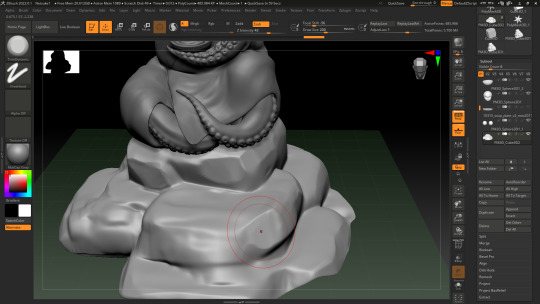
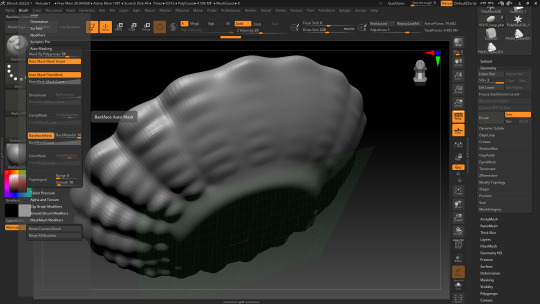
After that came the stage where I created the planter bowl. I quickly modelled it in 3dsMAX and imported it into ZBrush to add details. Then, to create wavy bumps on its sides, I used the "Standard" brush to carve into the bowl on both sides. I wanted to make sure that the brush only affects one side at a time, so I researched how to do it online. I found this video by Follygon on YouTube which introduced me to backface masking for brushes (https://youtu.be/G_pEfhDqtZY).
At first, the backface masking was very useful, but I later realised that using it had a potentially bad effect. Both sides of the surface no longer had a connection and were independent, this caused them to overlap in places where the surface had been pushed too far in or out. Unfortunately, this was not clearly visible inside of ZBrush and I only realised it had happened after exporting the object later on. I ended up fixing it afterwards by using the backface mask again and pushing the mesh in the opposite direction in places where it overlaps.
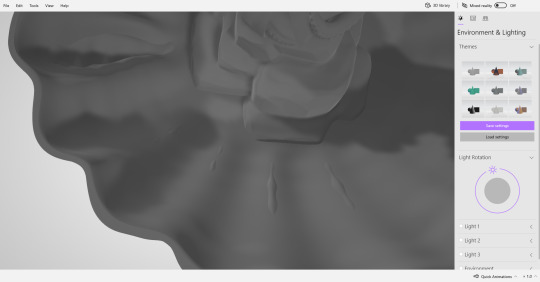

The final step was to get the sculpt ready to be exported. Meanwhile, the subtools were too high in polygon number so I had to reduce them somehow. For that, I remembered a tool that was discussed during class, which is ZBrush's "Decimation Master". It turned out to be relatively easy to use as I only had to do two steps: preprocess all the subtools first, then decimate second. What this allowed me to do is reduce the number of polygons while keeping the sculpted details intact by transforming the mesh into triangular faces. In the end, I exported the entire object as an STL file which is ready for printing.
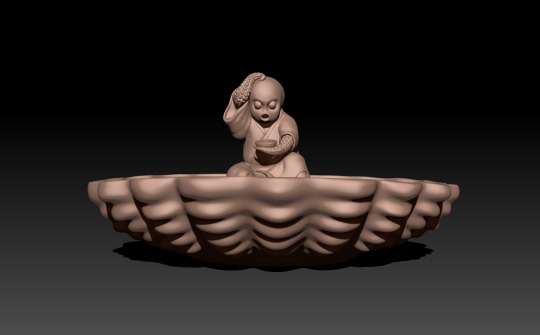
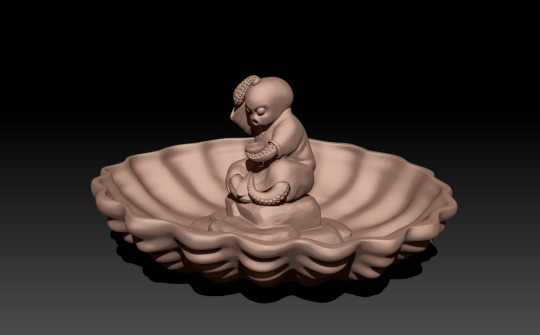
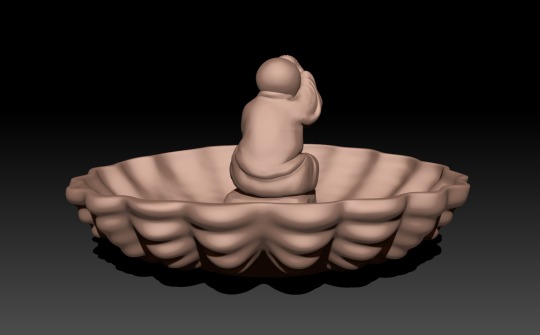
Sources:
IceCrystal ART (2019). How to Create Stylized Rock for Games Speed Art / 3ds Max / ZBrush / Substance Painter. YouTube [online video] Available at: https://youtu.be/phgEOyqhDuo
Follygon (2019). How To Use Backface Masking In ZBrush. Youtube [online video] Available at: https://youtu.be/G_pEfhDqtZY
0 notes
Text
CENTRALIZER (aka MASTERLIST)
What can go on behind the process of learning your target language
VOCABULARY
Basic vocab: Verbs, Nouns, Adverbs, Adjectives
Basic vocab: KANJI numbers, HIRAGANA, KATAKANA, Adjectives, Animals
VOCABULARY CHEAT SHEETS (Days of the week, Months, colours, animals, all counters, numbers)
FLASHCARDS (numbers, counters, amount)
Vocab builder
Daily adjectives
Adjectives
Greetings
Directions
Electronic devices
Japanese money and shopping
Fire vocabulary
Math in Japanese
Math vocabulary
Numbers: How to count in Japanese
Numbers: How to count in Japanese (II)
How to count in Japanese: The ‘not-so-easy’ system
Home vocabulary
Christmas vocabulary and phrases
Valentine’s Day vocabulary and phrases
How people snore in different languages
Minna no Nihongo LESSON 1 - Vocabulary
Minna no Nihongo LESSON 2 - Vocabulary
Parts of the body
Parts of the body (II)
Parts of the body (III)
Parts of the body (IV)
The family (Jap + Kor)
The colours
The colours (II)
The colours (III)
The seasons
The seasons (II)
Spring vocabulary
Months of the year
Months of the year (II)
Days of the week
Days, months, years
Days, weeks, months, years (II)
The time
Verbs
Verbs (II)
School Subjects
Prepositions of place (Positions)
Most common nouns in Japanese
GRAMMAR
BASIC JAPANESE CHEAT SHEET
BASIC JAPANESE CHEAT SHEET (II)
How to study when you don’t want to
Subject and Object pronouns; Posessive pronouns and adjectives
Sentence Structure and particles
Time expressions CHEAT SHEET
Basic Japanese Grammar: PARTICLES
Basic Japanese Grammar: PARTICLES (II)
Basic Japanese Grammar: PARTICLES (III) The difference between ha/wa and ka
Basic Japanese Grammar: QUESTION WORDS
Basic Japanese Grammar: COUNTERS
Basic Japanese Grammar: COUNTERS (II)
N5 GRAMMAR SHEET
N5 COMPLETE GRAMMAR LIST
WRITING
KANA charts
HIRAGANA Vowels
KATAKANA The difference between SHI and TSU
KATAKANA The difference between SHI, N, TSU, SO
KATAKANA: Differences
KANJI: Difference between 名 and 名前
KANJI: Pronunciation
N5 KANJI
N5 KANJI (II)
N5 KANJI (III)
N5 KANJI (IV)
N5 KANJI (V)
N5 KANJI (VI)
N5 KANJI (VII)
N5 KANJI (VIII)
N5 KANJI (IX)
N5 KANJI (X)
N5 KANJI (XI)
KANJI Conundrums
VOCABULARY
Expressions:
It started to get dark. (Dark)
Welcome home.
I’m home!
Gratitude before meals: itadakimasu
It has been a long time!
Japanese Phrases: Explained
Japanese Phrases: Explained (II)
Japanese Phrases: Expressing Desires
Japanese Phrases: Greetings, Worries and Love
Japanese Phrases: Useful materials for a presentation
Individual words and KANJI:
Types of coffee
Work/Job/Occupation
Wind/Breeze
Paper
Behind/Rear/After/Later
Bad/Poor/Inferior/Evil
Anger/Rage/Fury/Hatred
Time/Hour
Laughter
Wall
Menu
Maybe
Foreigner/Foreign citizen
Friend/Companion
To arrive/To reach
To die/ To pass away
To sleep/To go to bed
To be placed on/To appear
To walk
To remember/To memorize
To say/To tell/To utter
To show/To display
To teach/To inform/To instruct
To get up/To rise/To wake up
To sit
To push/To press
To rest/To have a break
To take (a photo)
To go out/To vanish/To disappear
To swim
To wait/To anticipate
To cross over/To go across
To get in/To go in
To read
To write
To close/To shut
To cut/ To chop/ To slice
To make/ To produce
To work/ To labour
To eat
To wear (from shoulders down)
To go/ To move
To see/ To look/ To watch
To borrow/ To have a loan
To take off (clothes, shoes)
To stick/ To paste/ To affix
Chair
Salt
Sugar
Book
Library
Bank
Envelope
Spectacles/Glasses
Coincidence/ Agreement/ Match
English (Language)
Morning a.m.
Afternoon p.m.
Black
Green
Tree
Student (overseas)
Postcard
Saturday
Movie theater/Cinema
Cat
Fish
Unappetizing
Refrigerator
Last year
Every day
Monday
Light (not heavy)
Stamp (postage)
Lecture/Address/Speech
Safe/All right/Okay
Hand
Garden/Yard
Weather/Element
Sea/Ocean/Waters
Mouth/Opening/Hole
Man/Male/Fellow/Guy
Younger brother/Little brother
Siblings/Brothers and Sisters
Far/Distant
Scientist
Pain
For the first time
Meaning/Significance
Talk/Speech/Story
New/Fresh/Recent/Latest
Cold/Chilly
Myself/Yourself/Oneself
In/Inside/Among
Below/Down/Under
Pretty/Lovely/Beautiful
Question/Problem/Issue
Name/Fullname/Given name
Young/Youthful/Immature
Hot/Warm
Weak/Frail/Delicate
Famous/Fame
Fast/Quick/Hasty
Outside/Exterior
Mountain/Heap/Pile
RESOURCES
Have a laugh
Learning tips
Learning tips (II)
Taking BREAKS from learning: 5-minute breaks and 15-minute breaks (and what to do in the meantime)
Japanese Resources (Writing: Hiragana, Katakana, Kanji; Dictionaries; Grammar; Vocabulary; Tools & Apps; Reading; Listening)
Textbooks, Online and phone dictionaries, ONline reading, Imrpoving your speaking, Listening, Reading and writing practice, News, Podcasts and radio, YT, TV, Tumblr, Blogs, Websites for Learning Japanese
Ultimate Japanese Language Learning Resource List
Japanese Listening Practice for Beginners
YouTube channels for learning languages
Books to learn Japanese (online, free)
Printable KANJI worksheet
A guide to speaking Colloquial Japanese
Art
Manga for beginners in Japanese
Watching and Listening in Japanese
Japanese study apps
#MASTERLIST#Japanese Masterlist#n5 kanji#n5 vocabulary#n5 japanese#n5 learn#n5 beginner#resources#japanese resources#writing japanese#listening japanese#reading japanese#speaking japanese#Japanese cheat sheet
305 notes
·
View notes
Note
What does a rapid fire Bird Secondary look like ?
Me!
I've talked about this a bit before, but I don’t like detailed plans, like step by step "here's what I'm gonna do." There are circumstances when I'll plan, but rather limited ones:
For fun. Maybe I'm interested in something but can't do the actual activity, so I plan it out instead. This plan might serve as a reference later, but I'm just as likely to discard it because I don't feel like using it or I have a better idea.
As a crutch. If I'm really inertia-struck with anxiety or executive dysfunction, making a plan or even just a list can be a hack to get out of it, but again, I'm likely to abandon it halfway through if I start feeling better.
"Formal" experimentation. I don't do this a whole lot, and usually I do this kind of thing in my head... but sometimes you gotta actually think the details through and write them down in advance.
But it's not how I like to work. To me, plans feel brittle and restrictive and usually boring. I lean towards other tactics:
Clever repurposing of something I learned/collected, or of resources that happen to be around me
Use of a tool I picked up thinking "this'll be handy at some point"
Bringing up weird knowledge I acquired At Some Point, possibly by accident, for fun, or while working on something else
Bringing up general skills I learned on purpose
Learning skills on the fly because the situation needs them; I prefer to know what I'm doing better than this, but reasonably speedy autodidacticism is one of my most prized skills and it's not a bad fallback.
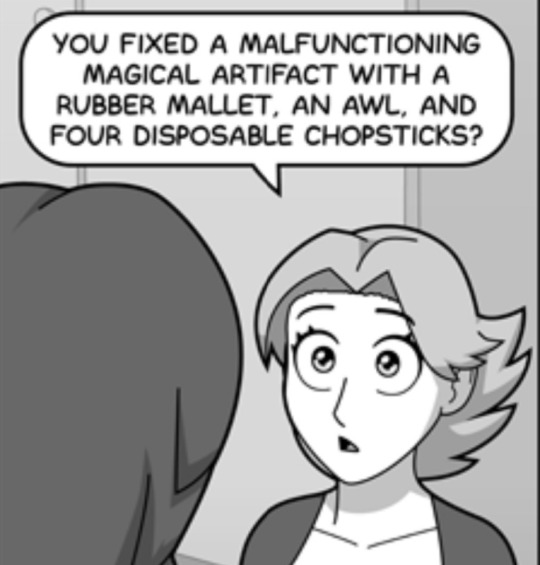
(El Goonish Shive)
"Moooom! Paint is identifying with a mad scientist character again!"
Basically, I pull from my collection of existing skills, tools, knowledge, and current available resources to craft a solution on the fly, after getting close enough to the situation to get a good look at the problem.
This makes me feel very clever, it works really well, and I love doing it. Favorite way to do stuff, hands down.
Trouble can be, if people don't recognize how much prep work goes into these "instant" solutions, they're inclined not to believe they're real and will actually work. And I don't like pulling the "actually I studied this for six months" card because it feels like bragging :/ plus, for all the different things I can say that about, it stops sounding believable.
Truth is, I have almost no attention span for television (I'm aware this is weird but don't have an explanation for it), I hyperfocus easily, and I choose hobbies with lots of moving parts.
Like aquascaping. Do you know how many different bottles of chemicals you need to get the water chemistry right so the aquatic plants will grow? For me it was five, but a lot of people I knew online had waaay more (and fancy CO2 systems) because they kept demanding plants. If you kept the right balance of fish and plants, you ended up with this little ecosystem in a box. Like a tiny slice of a river! I was pretty good at it.
I still don't know how I got from "let's try making California rolls" to "afraid to run out of good mirin," but somehow I ended up really into cooking Japanese food and it's a permanent influence on my pantry and basically anything I cook now.
I do know how I ended up with so many oil painting mediums and solvents and so many paint colors that I have to have a list on my phone now to keep track of which ones I have in stock, though. Also did you know that acrylic paints also have mediums you can add and they make using acrylics SO MUCH EASIER? because I do and it seems like nobody else does and that's sad.
I also binge read nonfiction, especially when I'm depressed. It gives me something to focus on and feels vaguely productive even when I don't have the energy to do more.
Does this all sound like a lot of work? It's really just some of the stuff I do for kicks. We haven't touched on the novels I've written, the coding languages I know, the gardens I've kept, the professional design software on my computer (which I built myself from parts), the knitting and the baking and the graphic design and the candle making and the martial arts and the French language stuff from back in high school that I still kinda remember.
OH and then you have the weird stuff I carry around. *empties purse* here we have a multitool, lockpicks, a can of WD-40, some yarn or string, bandaids, a styptic pen, hand sanitizer, hairbands, screws I don't want to lose bc they belong to my couch, glasses cleaning wipes, a metal pen with a point that can break a car window, a bunch of fast food napkins, mini bottles of ibuprofen and acetaminophen, earbuds, comb, random lanyard, and four mini rubber ducks; all of these make sense to me don't ask why my purse is heavy
Plus all the ebooks loaded onto my phone, which I carry everywhere! And I have even more in my Humble Bundle library.
I list all these off to make a point: Birds' resource libraries can be HUGE. I don't know where mine exists on the hugeness spectrum, but I'm only 23, and older Birds' libraries are probably even bigger.
So yeah, as odd and niche as my interests can be, I have a LOT of them, and I can just go into situations without a plan because between all the skills I've learned and the books I've read and reread and the resources I carry everywhere and the hoard of supplies at home and the Bird masks and the Badger mirroring and THEN the ability to learn what I need on the fly if all else fails--
I don't need a plan.
I don't want a plan.
I'm more powerful without it.
I can react and pull from anything I've ever done or used or read. I can build things on the fly. Doesn't matter if I need to help cater an event or build a website or just prop open a heavy door--I'll have something relevant, or I'll figure it out.
There are situations where I won't be as capable, of course. For example, I know very little about cars, or writing music, or roller skating, or amino acid protein chains. But that's okay, because there are other people who specialize in those things, and I'll almost certainly come out of the situation having learned something and added to my library.
(Except the roller skating thing. I'm kind of phobic about skating of any kind. Cool when other people do it, but I get *eurgh* sliding in socks on linoleum.)
How do I end this... oh!
The fancy word for the act of making up a solution to a problem on the spot, using whatever materials and resources you have on hand, is bricolage, and one who practices it is a bricoleur. I learned that from a LiveJournal blog about writing that I used to read when I was 12, and I still remember it for some reason, which is very on brand of me.
25 notes
·
View notes
Text
Introduction to Shimenawa and Torii
And now I can finally get to what I wanted to talk about when I started my last info dump, the entrance to a Shinto Shrine. The Entrance to a Shinto Shrine is almost always marked by a Torii gate. But not always. Sometimes the entrance will be marked by a pair of lone posts, post connected by a Shimenawa rope, or a pair of trees linked with a Shimenawa rope. At the moment it would seem these are also referred to as torii when used to mark the approach of a shrine even though these gateways would not be recognizable as torii by most outside of Japan. The rope is usually made from rice straw, but can be made of hemp and even plastics. https://www.japanvisitor.com/japanese-culture/shimenawa
The use of plastic is a fairly modern practice. Rice and hemp will last about three years as I recall, depending on the environment, where plastic can last decades. The reason for using rice has nothing to do with a shortage of rice straw and everything to do with a shortage of people who know how to make the straw ropes. In early times rope might be used to mark out a property line. In order to distinguish between a property line and a sacred space straw tassels or paper strips (shide), or a combination of the two would be used. The shide are those little zigzag strips. The number and placing typically depends on the size and length of the rope as well as the custom of a given shrine and it’s intended use. The Shimenawa with shide is used for purification as well as marking out a sacred space. Plots of land will be marked with shimenawa prior to use, shimenawa can be used on torii, to encircle trees, mark out processional lanes, provide purification in shopping arcades, they may be used in the home for purification on new years, and placed in front of the household Shinto shrine known as a Kamidana. Oh, and if it’s available for sale on line it’s for primarily decoration use. The number of shide attached to the Shimenawa for home use will typically be three to four, but that’s not a hard and fast rule only a recommendation as an especially large shimenawa for home use could have up to five while a small one may only fit two. Recommendations regarding the placement of tassles and shide may be shrine specific as well. Shide can be displayed either in front of tassels or between. A quick online image search will show you that shide are normally attached between the tassels by most shrines but may also be placed directly in front of the tassels. Shimenawa come in a seemingly endless variety which each shrine having their own preferences. https://www.nippon.com/en/views/b05204/

From Wikipedia, a New Years decoration attached in place of the usual shide. By katorisi - Own work, CC BY 3.0, https://commons.wikimedia.org/w/index.php?curid=3323326 When used specifically for New Year’s festivities the Shiminawa may be displayed with oranges, fern, pine branches, and other festive ornamentation.
Keep in mind that there are two types of household shrines, the Shinto Kamidana and the Buddhist family alter.
Shimekazari (注連飾り) is a special type of Shimenawa that is looped.

The torii depicted is one I made, the Shimekazari on it came from the Portland Japanese Garden in Portland, Oregon. The entire arrangement was for New Years in 2018.
And now onto the Torii. Torii are nowhere near as endless in variety as shimenawa are. In deed there seems to be only about a dozen basic design shapes if we discount the wide verity of garden decor all claiming to be torii. As for the origin of torii, I’m inclined to think that the Japanese Torii originated independently to be influenced by Chinese design and aesthetics.
The most basic torii is the Shinmei torii. To build one you need two posts with a shimenawa stretched between also known as a chūren, or three logs and a board. Two logs for the upright, one log stretched across the top, and the board fitted between the uprights just a little lower than the top log, called a nuki. The Ise torii adds a section to protect the top crosspiece. This is the roof of the structure and called a kasagi. The entire top section is referred to as the Kasagi when it’s all one piece, otherwise that top section includes the Kasagi and the shimaki. Next in line is the Kashima torii, followed by Kasuga, Hachimon, and the Mihashira torii.
The Tōhafu torii seems to be it’s own unique style demonstrating both traditional and Chinese influences.
The Mihashira torii also known as the mitsubashira torii and sankaku torii. This torii is unique in that it has three posts, three nuki, and three kasagi. Only one is publicly accessible that I’m aware of, it has a cairn at its base as well. According to Janus: records also state that the three pillars symbolize the heavens, earth and mankind. There is also a reference in the record which asserts that this torii had a connection with Nestorianism, Keikyou 景教, an ancient Christian sect which thrived for about 800 years in the Near East and Central Asia. It is possible that the three-pillared torii may have had a Christian connotation. http://www.aisf.or.jp/~jaanus/deta/m/mihashiratorii.htm
For this reason the three-pillared torii has become rather controversial and has been denounced world wide by the very community who now clamor for everything Shinto. Looking on the internet I found at least two sites that look to be accessible but I have yet to verify this. Whether or not the possible connection to Nestorianism is real is immaterial. To practice Shinto is to accept all faiths, consider all possibilities, and to strive to live in harmony. It is only the destructive habits and teachings that are to be challenged and set aside.
After these we start seeing torii that show Chinese influence with upturned ends on the kasagi. These are the Myōjin family of torii wich include the basic Myōjin style, the Nakayama, Daiwa also known as the Inari torii, Ryōbu, Miwa, Usa,Nune, Sannō, and Hizen. Each having it’s unique differences.
Torii can be made of just about anything. Wood is the most popular, followed by stone and then iron. Some notable torii is the large speaker torii in Kamiyama, Tokushima, the Grecian inspired torii made by Kyoto artist Doumoto Insho which stands in the now abandoned Oiwa Jinja, the Motoki Torii which is a massive stone carved torii, the Otorii at Kumano Hongū Taisha which is 33.9 meters tall and 42 meters wide and the largest in the world, floating torii of Itsukushima Shrine on Miyajima, and finally I’m going to conclude this list with the One legged torii of Nagasaki. The one legged torii of Nagasaki is a survivor of the atomic blast and has become a sacred sight in its own right.

Image from Pinterest. Original source unknown.
One final note before this gets way too long. Expect to find torii and even shrines in unusual places if you ever get a chance to go to Japan. I will admit that I myself have yet to have the opportunity, but I’ve scoured the internet long enough to know that urban sprawl has on occasion completely enveloped shrines. In many ways I am lucky to live in the Pacific Northwest where there is a shrine even though I can’t go to it right now. I am hopeful that 2021 turns out better than the previous year.
I ran across the term chūren just as I was getting ready to post and found the above infographic that has most of the basic styles. Finding good solid info from reliable sources can be difficult. The practice of search engines to decide it knows better by delivering what it wants as apposed to what we are actually searching for can make some searches near impossible. The internet is also full of blogs written by people who just discovered the “New Faith” [face palms]. Yes, I actually saw someone referring to Shinto as a new faith. Um, no, it’s hundreds, perhaps even thousands of years old.
What I want for you as the reader is to have the tools to be able to do informed research of your own. Don’t be afraid to ask questions of others. Be weary of anyone who is dogmatic in their thinking. And finally, always remember that Shinto is a culturally sensitive tradition with many facets. If it’s not of Japanese origin, it’s probably not part of Shinto and shouldn't be mixed.
6 notes
·
View notes